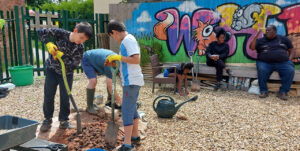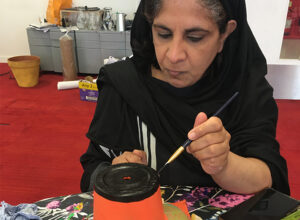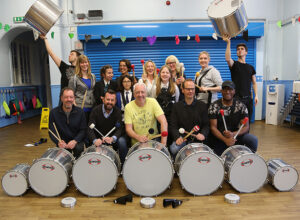Did Creative Civic Change projects have freedom to fail?
This is part of a series of reflections on Creative Civic Change, Local Trust’s experimental funding programme that supported 15 communities across England to shape, lead and commission arts and creative interventions, to make positive social change where they lived.
The Creative Civic Change evaluators asked Professor Leila Jancovich, from the Hard Times Require Furious Dancing project, to hold a WhatsApp conversation with three Creative Civic Change areas to find out how these projects defined, talked about, and responded to failure. This piece explores the theme of failure and shares quotes from actual WhatsApp conversations about it.
Leila leads on Failspace, a research project exploring how the cultural sector can better recognise, acknowledge and learn from failure. It introduces a framework to consider success and failure across different facets or criteria, to different degrees, for different people and at different stages.

Young people gardening as part of the Hard Times Require Furious Dancing Creative Civic Change project
Using this framework the three Creative Civic Change projects defined failure more in terms of the level of participation and their core purpose than in terms of individual activities and valued failure as a way of learning and adapting their work. There is more work to be done however in fully ‘mainstreaming’ failure throughout the funding process.
What did success and failure look like for Creative Civic Change projects?
Creative Civic Change projects considered failure through multiple lenses, but three dominant themes emerged from the discussion. These are:
Participation
In the Failspace research this relates not only to who takes part but also their level of agency:
“I think our main focus was on community ownership and making sure decisions were resident-led … if residents hadn’t been active (both on the steering group and through their participation) then the project would definitely have failed.”
A focus on participation allowed projects to flex their expected activities in response to the community’s feedback. For example, one project with a focus on “placemaking” shifted their aspirations from physical artworks to “greening” underused community spaces.
Purpose
The second, connected, theme was purpose, which in the Failspace research relates to staying true to the core mission, and was reflected by the Creative Civic Change projects:
“Failure we think is giving up in the face of challenges…Purpose is key, why rather than how…the hows come as you respond to community…the whys are always the same and need to be kept at the heart.”

A group of people involved in the Creative Newington gather as part of the Creative Civic Change programme
This sense of failure as giving up is particularly important in the context of “ignored” communities, where failure may be expected both externally and internally:
“All the…negativity that are talked about with regards to our communities, some people tend to wear them as clothes…I remember saying that…we don’t need to carry or wear these wrong jackets, which have the wrong things written about us…we should really take them off and walk free.”
Process
This was also an important lens for failure in the Failspace research – for example, in assessing particular activities that succeeded or failed, but unlike many other creative projects, in Creative Civic Change this was secondary to the lenses of process and purpose.
The Failspace research also identifies two other facets of success and failure: profile (the reputation and future prospects of the organisations and professionals involved) and practice (the creative and cultural intentions or aspirations of the project). These were also relevant to Creative Civic Change projects:
“There was a feeling that we could, that there would be a lot of connections between our [local organisations] and CCC. But that never materialised. In fact, we have not had a connection… [they] viewed us as competitors.”

A person painting as part of the Hard Times Require Furious Dancing Creative Civic Change project
How was talking about failure valuable within Creative Civic Change projects?
All three areas used their working groups as a space to discuss failure. For some working groups, embracing failure offered an important opportunity to learn and change, leading to better outcomes:
“Our overriding approach was to dissect what had happened, our role and what we could of done (or do) differently … sometimes this produced some of our biggest successes”
Learning from failure also helped to build confidence and resilience within working groups:
“It’s also an example for participants that things don’t always turn out as planned and that’s ok…to gain confidence in trying, again and again. Learning not to beat yourselves up…having patience with yourselves and the process.”
However, the word ‘failure’ was not always used and could even be contentious:
“I found that, with professionals, those are the ones who felt a bit uncomfortable and…would say, oh, these are challenges or would encourage other residents or other members of the group to not call them failures, almost out of fear that it would be seen that they had failed us.”
Failure could also be difficult to discuss, stirring up feelings of disempowerment, defeat, tiredness, fear, upset and defensiveness. For one project, navigating these feelings meant that they took a pragmatic approach to failure:
“We sort of accepted it quietly, and then just moved on to the next thing.”
Key to the Failspace research findings is that space must be given not just to acknowledge failure but learn from it in order to improve practice. As one project noted:
“It’s not really that we avoided the word ‘failure’ but rather that we wanted to learn from the experience and improve…We certainly admitted things had failed!”
What made it difficult for projects to define and discuss failure?
Definitions of success and failure
Different definitions of success and failure can make discussing failure difficult. Within Creative Civic Change projects, some stakeholders (for example governance groups) placed emphasis on process (delivering a particular plan) over participation and purpose:
“It’s tough when you work with folks who are less keen on those learning opportunities…risk-averse people who want everything to work out to the original plan…”

People performing at Whitley Bay, a Creative Civic Change project
Limited time, space and resource for reflection
One key barrier to reflecting on and discussing failure was having the time, space and resources for reflection:
“So you are almost just pursuing success and turning a blind eye to failure because there is no time and space and resources to deal with that”.
The language of failure
The language of “failure” was not fully mainstreamed throughout the programme. Whilst there was space to discuss challenges and learnings in the programme (for example project reporting and peer learning), these did not expressly use the language of failure.
This had an impact for projects on defining success and failure – for example – in an early evaluation workshop projects were encouraged to define what success – but not failure – would look like.
Lack of an express positive orientation to failure
This also created pressure on some projects to pursue success. This is particularly important due to:
“The legacy of former grants, where it’s such an issue to fail, and then maybe to have to give back the money or to have to stop the project…that still haunts a lot of people. But CCC was not like that.”
Those with power using the word failure
The word “failure” needs to be expressly used and positively valued by those with power, including funders, evaluators and more. Otherwise the onus is on those with the least power, the grassroots, to instigate the conversation:
“If that language doesn’t even exist from the funder, if the funder and his criteria and all their criteria don’t allow for failure to be talked about. There is no way I feel that can be talked about by the recipients of funding. Especially us, grassroots organising…we don’t have enough clout to talk about failure.”
What made it possible for projects to define and discuss success and failure?
Despite these challenges, Creative Civic Change projects did value discussing and learning from failure:
Strong relationships
These made it possible for projects to both define and discuss success and failure:
“On balance I think the critical factor in being able to talk about/address failure was due to the relationships the working group built…as a group but also with one another.”
All projects agreed that relationships of trust, care, and honesty between working group members was vital in developing spaces to explore failure – especially when people were coming from very different places.
Depersonalising failure
Creative Civic Change projects listened to their communities, including around what was and wasn’t working. This, combined with the collective decision-making within working groups, helped to depersonalise failure:
“Interestingly I can’t remember an instance when this became about (individual) responsibility but was rather a chance to problem solve collectively.”
Interestingly, as in the Failspace research, those professionals (artists and others) who were most likely to avoid the language of failure seemed to be those who felt that failure sat on their shoulders personally.

A band that was part of the Whitley Bay Creative Civic Change project
Flexibility
Having an expressly flexible plan, with space to evolve and respond to the community, helped projects to define success and failure in ways that didn’t centre on predefined activities, and made space for projects to adapt and flex to changing circumstances, including COVID-19:
“We often think of our work as a journey without a map. We know sort of where we want to end up but are willing to be led and taken off the beaten expected tracks by what community want.”
The length and flexibility of Creative Civic Change funding was an important factor in making this possible:
“We always felt that the programme was giving us the freedom to “try” and then see what happened…”
But more can still be done to incorporate Creative Civic Change projects’ learnings and support the ‘mainstreaming’ of failure:
“Having the flexible funding of CCC and 3 years has given us more freedom to try new, braver things. More time built in to reflect would always be a good plan, which we find we are too busy doing to actually make happen.”
Thanks to Leila Jancovich, Dadirai Tsopo from Hard Times Require Furious Dancing, Charlie Fox from Creative Newington, and Sarah Sutton from Whitley Bay Big Local for this piece.
To find out more about what the 15 Creative Civic Change projects achieved and conclusions made in the evaluation of the programme, visit the website.
